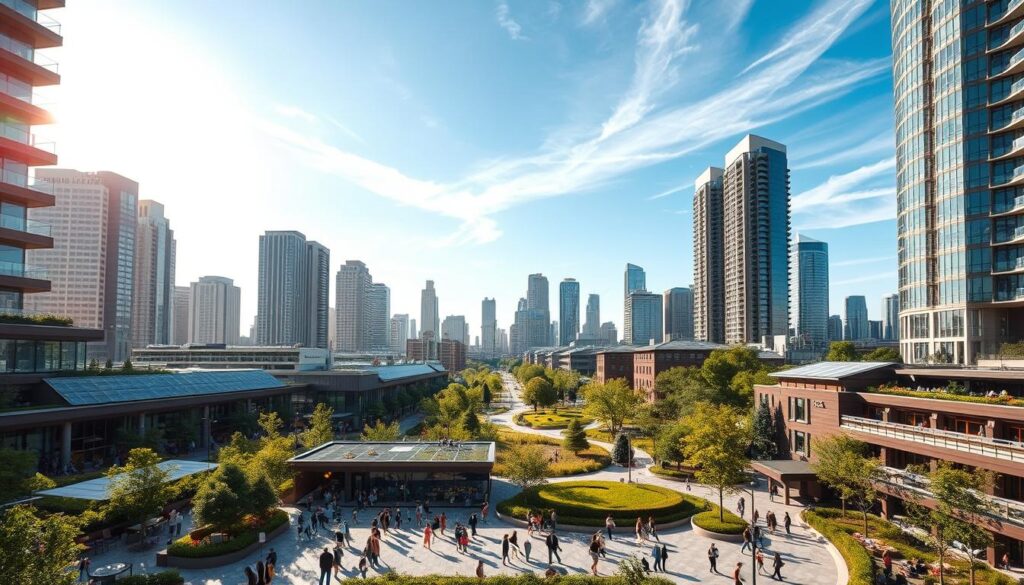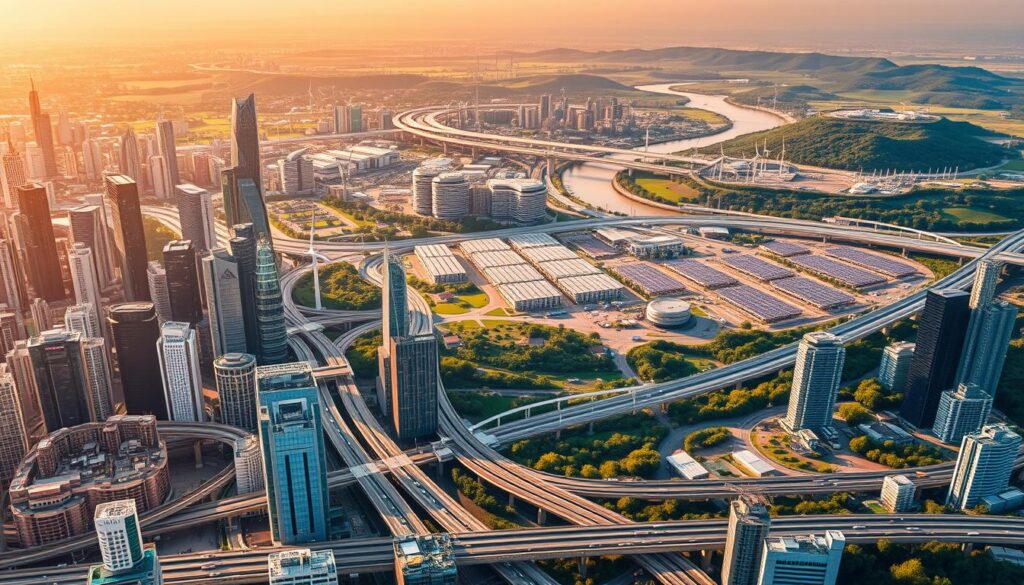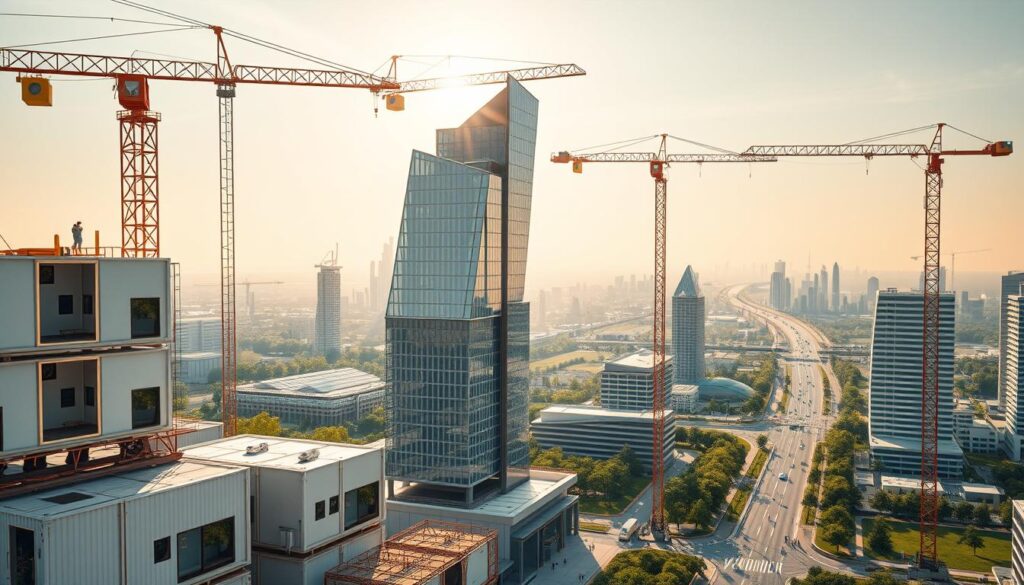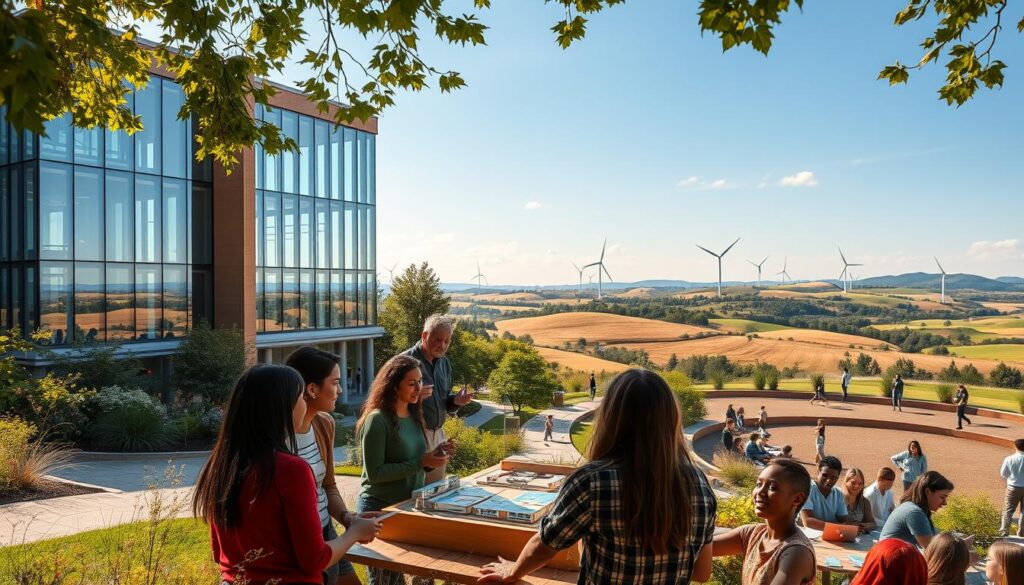The world’s infrastructure is facing unprecedented challenges, with climate change and urbanization putting a strain on existing systems. It’s estimated that $3 trillion is spent annually on global infrastructure, yet many communities still lack access to basic services like clean water and sanitation.
Sustainable infrastructure solutions are critical to addressing these challenges. By prioritizing long-term economic, social, and environmental benefits, we can create a more resilient global economy. The World Civil Society is at the forefront of promoting sustainable infrastructure practices, empowering communities through thoughtful design and innovation.
Key Takeaways
- Sustainable infrastructure delivers long-term economic benefits.
- It addresses social challenges by providing access to basic services.
- Environmental benefits are achieved through sustainable practices.
- Innovative solutions are crucial for a resilient global economy.
- Global collaboration is necessary for successful infrastructure development.
Understanding Sustainable Civil Engineering
As the world grapples with environmental challenges, sustainable civil engineering emerges as a vital solution. Sustainable infrastructure systems are those that are planned, designed, constructed, operated, and decommissioned in a manner that ensures economic and financial, social, environmental (including climate resilience), and institutional sustainability over the entire infrastructure life cycle.
What is Sustainable Civil Engineering?
Sustainable civil engineering involves the application of sustainable practices throughout the lifecycle of infrastructure projects. This includes using eco-friendly materials and innovative techniques to minimize environmental impact. For instance, the use of recycled materials in construction not only reduces waste but also conserves natural resources.
According to recent developments in the field, institutions like KRCT are at the forefront of teaching sustainable infrastructure and innovative civil engineering concepts.
The Importance of Sustainability in Civil Engineering
The importance of sustainability in civil engineering cannot be overstated. With the global population projected to continue growing, the demand for infrastructure will increase, making it crucial to adopt sustainable practices to mitigate environmental impacts. Sustainable civil engineering helps in reducing carbon footprints, conserving resources, and enhancing the quality of life for communities.
Key Principles of Sustainable Practices
The key principles of sustainable practices in civil engineering include:
- Minimizing environmental impact through efficient use of resources
- Using renewable energy sources and reducing dependence on non-renewable resources
- Implementing waste reduction and recycling programs during construction
- Designing infrastructure that is resilient to climate change
By adhering to these principles, civil engineers can contribute to creating a more sustainable future.
Current Trends in Sustainable Infrastructure

As the world moves towards achieving the Sustainable Development Goals by 2030, innovative infrastructure solutions are becoming increasingly crucial. The need for significant investment in sustainable and resilient infrastructure has never been more pressing, with the goal of reaching net zero emissions by 2050.
The current trends in sustainable infrastructure are transforming the way we develop and manage our built environment. These trends are not only environmentally friendly but also offer long-term economic benefits.
Green Building Technologies
Green building technologies are at the forefront of sustainable infrastructure development. These technologies include energy-efficient systems, sustainable materials, and innovative design practices that minimize environmental impact.
- Efficient Energy Systems: Incorporating renewable energy sources and energy-efficient systems to reduce carbon footprint.
- Sustainable Materials: Using materials that are recycled, recyclable, or sustainably sourced.
- Innovative Design: Implementing designs that maximize natural light, reduce water consumption, and promote biodiversity.
Renewable Energy Integration
The integration of renewable energy into infrastructure is a critical trend. This involves not just the installation of solar panels or wind turbines but also the development of smart grids that can efficiently distribute renewable energy.
Smart grids are revolutionizing the way energy is managed, allowing for real-time monitoring and adjustment to energy distribution. This not only improves efficiency but also enhances the resilience of the energy supply.
Smart City Innovations
Smart city innovations are transforming urban living by leveraging technology to create more sustainable, efficient, and livable cities. This includes the use of IoT devices, data analytics, and smart transportation systems.
- IoT Devices: Enhancing infrastructure management through real-time data collection and monitoring.
- Data Analytics: Analyzing data to optimize city operations, from traffic management to waste management.
- Smart Transportation: Implementing intelligent transportation systems to reduce congestion and emissions.
These trends are shaping the future of sustainable infrastructure, contributing to a more resilient and environmentally friendly world. As we continue to innovate and invest in sustainable solutions, we move closer to achieving our global sustainability goals.
Materials Used in Sustainable Engineering
Sustainable engineering relies heavily on innovative materials that minimize environmental impact. The use of such materials is crucial in reducing the ecological footprint of construction and infrastructure development projects.
Recycled Materials
Recycled materials play a significant role in sustainable construction practices. By reusing materials from demolished buildings, such as concrete, wood, and metal, the need for virgin resources is significantly reduced. This approach not only conserves natural resources but also decreases the amount of waste sent to landfills.
For instance, recycled concrete can be used as aggregate in new concrete mixes, reducing the demand for natural aggregates. Similarly, reclaimed wood can be repurposed for various applications, from structural elements to decorative features.
Eco-Friendly Alternatives
Eco-friendly alternatives are being increasingly adopted in sustainable construction. Materials such as bamboo, low-carbon concrete, and recycled plastic are becoming popular due to their lower environmental impact. Bamboo, for example, is a highly renewable resource with a lower carbon footprint compared to traditional wood.
Low-carbon concrete is another eco-friendly alternative that reduces the environmental impact of traditional concrete production. This is achieved by using supplementary cementitious materials (SCMs) or alternative binders that lower the carbon content of the concrete.
High-Performance Concrete
High-performance concrete (HPC) is a type of concrete that meets specific performance requirements, such as high strength, durability, and resistance to environmental factors. HPC is made using advanced materials and techniques, including the use of SCMs and specialized admixtures.
The benefits of HPC include improved structural integrity, reduced maintenance needs, and enhanced sustainability. For example, HPC can be designed to have a longer service life, reducing the need for frequent repairs or replacements. To learn more about sustainable building materials, visit World Civil Society.
| Material | Benefits | Applications |
|---|---|---|
| Recycled Concrete | Reduces waste, conserves natural resources | Aggregate in new concrete, road base |
| Bamboo | Highly renewable, lower carbon footprint | Structural elements, decorative features |
| Low-Carbon Concrete | Lower environmental impact | Building foundations, infrastructure projects |
“The use of sustainable materials in construction is not just a trend; it’s a necessity for the future of our planet.” – Expert in Sustainable Engineering
Case Studies of Successful Projects

Global infrastructure development is increasingly leaning towards sustainability, with several projects setting new benchmarks in eco-friendly construction. This shift is driven by the need to reduce environmental impact while promoting economic growth and social well-being.
Notable Green Buildings in the U.S.
The United States has been at the forefront of adopting green building technologies. One notable example is the One World Trade Center in New York City, which is one of the most sustainable skyscrapers in the world. It features a range of eco-friendly elements, including a glass and steel façade that reduces wind loads and provides natural light.
- Energy-efficient systems reducing energy consumption
- Rainwater harvesting system for irrigation and toilet flushing
- Recycled materials used in construction
Innovative Infrastructure in Europe
Europe has been a hub for innovative infrastructure projects, with many countries leading the way in sustainable urban development. The Amsterdam Smart City initiative is a prime example, focusing on sustainable energy, green roofs, and intelligent traffic management.
This project showcases how integrating technology and sustainability can create a more livable and efficient urban environment.
Lessons from Global Sustainable Projects
Global sustainable projects offer valuable insights into the challenges and opportunities associated with green infrastructure development. A key lesson is the importance of stakeholder engagement and community involvement in the planning process. For more information on tackling grand challenges in engineering, visit World Civil Society.
- Innovative financing models can accelerate project implementation
- Collaboration between governments, private sector, and NGOs is crucial
- Adaptive design strategies can help mitigate the impacts of climate change
The Role of Technology in Sustainability
The integration of technology in civil engineering is pivotal for advancing sustainable practices globally. As the world grapples with the challenges of climate change, environmental degradation, and urbanization, technology offers innovative solutions to these complex problems.
Digital Tools for Sustainable Design
Digital tools are revolutionizing the field of civil engineering by enabling more efficient and sustainable design processes. Building Information Modeling (BIM) is one such tool that allows for the creation of detailed digital models of infrastructure projects, facilitating better planning, execution, and management. BIM enhances collaboration among stakeholders and reduces the environmental impact of construction by minimizing waste and optimizing resource use.
Other digital tools, such as computer-aided design (CAD) software, are also crucial for sustainable design. They enable engineers to simulate various scenarios, predict potential issues, and make informed decisions that reduce the environmental footprint of their projects.
Geographic Information Systems (GIS)
Geographic Information Systems (GIS) play a vital role in sustainable civil engineering by providing a platform for spatial data analysis and visualization. GIS technology helps engineers and planners assess environmental impacts, identify optimal locations for infrastructure projects, and develop strategies for sustainable land use.
“GIS has become an indispensable tool in our toolkit for planning and managing infrastructure projects sustainably,” said Jane Smith, a leading civil engineer.
A notable application of GIS is in the planning of transportation systems. By analyzing spatial data, engineers can design more efficient routes that minimize environmental disruption and enhance connectivity.
| Technology | Application in Sustainability | Benefits |
|---|---|---|
| BIM | Sustainable Design and Construction | Reduced waste, improved collaboration |
| GIS | Spatial Data Analysis for Infrastructure Planning | Enhanced environmental assessment, optimized land use |
| Drones | Infrastructure Monitoring and Inspection | Increased safety, reduced inspection time |
Drones in Infrastructure Monitoring
Drones are increasingly being used in civil engineering for monitoring and inspecting infrastructure. Equipped with high-resolution cameras and sensors, drones can capture detailed data on the condition of structures, such as bridges and roads, without the need for physical inspections.
The use of drones not only enhances safety by reducing the risk to human inspectors but also increases efficiency by speeding up the inspection process. This allows for more frequent monitoring and the early detection of potential issues, thereby extending the lifespan of infrastructure.
Community Engagement and Sustainable Infrastructure

The role of community engagement in sustainable infrastructure cannot be overstated. As cities continue to grow and evolve, the need for infrastructure that is not only sustainable but also resilient and responsive to community needs becomes increasingly important.
Involving Stakeholders in Planning
Involving stakeholders in the planning process is a critical step towards creating sustainable infrastructure. This includes not just government agencies and private developers, but also the local community, businesses, and other interest groups. By engaging stakeholders early and often, planners can ensure that projects meet the needs of the community and are more likely to be supported and adopted.
Benefits of Stakeholder Engagement:
- Increased project support and adoption
- Better alignment with community needs
- Improved project design and functionality
Education and Awareness Campaigns
Education and awareness campaigns play a vital role in promoting sustainable infrastructure. By educating the public about the benefits of sustainable practices and the importance of community engagement, cities can foster a culture of sustainability.
Effective education and awareness strategies include:
| Strategy | Description | Impact |
|---|---|---|
| Public Workshops | Hands-on sessions where community members can learn about sustainable practices | Increased community engagement |
| Social Media Campaigns | Utilizing social media platforms to disseminate information and engage the community | Broad reach and increased awareness |
| School Programs | Integrating sustainability education into school curricula | Long-term cultural shift towards sustainability |
Building Community Resilience
Building community resilience is another key aspect of sustainable infrastructure. This involves not just physical infrastructure, but also social and economic resilience. By engaging the community in the planning process and promoting education and awareness, cities can build resilience that benefits everyone.
Through these efforts, communities can develop infrastructure that is not only sustainable but also resilient and responsive to the needs of its citizens.
Regulatory Frameworks Supporting Sustainability
Regulatory frameworks are essential in guiding the civil engineering industry towards more sustainable practices. These frameworks encompass a range of standards and policies that ensure infrastructure development is environmentally friendly and sustainable.
Understanding LEED Certification
LEED (Leadership in Energy and Environmental Design) certification is a widely recognized standard for sustainable building practices. It provides a framework for designing, constructing, and operating buildings in an environmentally friendly manner. Projects earn points across various categories, including energy efficiency, water usage, and material selection, to achieve different levels of certification.
For instance, a project that incorporates renewable energy sources, such as solar or wind power, can significantly increase its LEED score. This not only contributes to a reduction in environmental impact but also enhances the project’s marketability and value.
Local and National Policy Initiatives
Local and national policy initiatives play a crucial role in promoting sustainability. Governments around the world are implementing policies that encourage or mandate sustainable practices in construction and infrastructure development. For example, some countries offer incentives for green building, such as tax credits or expedited permitting processes, to encourage developers to adopt sustainable practices.
Moreover, policies that require sustainability frameworks to be integrated into project planning can significantly enhance compliance with environmental standards. This integration ensures that sustainability is considered at every stage of the project lifecycle.
Environmental Impact Assessments (EIA)
Environmental Impact Assessments are a critical tool in the regulatory framework supporting sustainability. EIAs involve a systematic process to identify and evaluate the potential environmental impacts of a proposed project. This process helps in developing strategies to mitigate adverse effects and ensures that projects are designed and implemented in an environmentally responsible manner.
The EIA process typically includes public consultation, allowing communities to have a say in projects that may affect their environment. This not only enhances transparency but also fosters community support for sustainable projects.
In conclusion, regulatory frameworks, including LEED certification, local and national policy initiatives, and environmental impact assessments, are vital in supporting sustainability in the civil engineering sector. By understanding and adhering to these frameworks, the industry can continue to move towards more sustainable practices.
Economic Benefits of Sustainable Engineering

The economic benefits of sustainable engineering are multifaceted, ranging from cost savings to job creation. As the world continues to invest in global infrastructure development, understanding the financial advantages of sustainable practices becomes increasingly important.
Cost-Benefit Analysis of Green Projects
Conducting a thorough cost-benefit analysis is crucial for evaluating the viability of green projects. While initial investments in sustainable technologies may be higher, the long-term benefits often outweigh these costs. For instance, energy-efficient systems reduce operational expenses over time.
Key benefits of green projects include:
- Reduced energy consumption
- Lower maintenance costs
- Increased property values
Job Creation through Sustainable Initiatives
Sustainable initiatives not only contribute to environmental conservation but also play a significant role in job creation. The renewable energy sector, for example, has seen substantial growth, creating new employment opportunities in manufacturing, installation, and maintenance.
The growth in sustainable industries is expected to continue, driven by government policies and increasing public demand for green technologies.
Long-Term Savings from Efficient Infrastructure
Efficient infrastructure is a cornerstone of sustainable engineering, offering significant long-term savings. By utilizing materials and designs that minimize environmental impact, infrastructure projects can reduce their overall lifecycle costs.
- Implementing recycled materials in construction
- Designing for energy efficiency
- Optimizing water usage
These strategies not only contribute to cost savings but also enhance the resilience and sustainability of infrastructure, supporting global infrastructure development.
Barriers to Implementing Sustainable Solutions
Despite the benefits, several obstacles hinder the adoption of sustainable solutions. The transition to sustainable infrastructure is complex and faces numerous challenges.
One of the primary barriers is financial constraints. The initial investment required for sustainable infrastructure can be substantial, deterring some organizations from adopting green technologies. For instance, the cost of implementing renewable energy sources or green building materials can be higher than traditional methods.
Financial Constraints
Financial constraints are a significant hurdle. The high upfront costs associated with sustainable infrastructure projects can be a deterrent. However, it’s essential to consider the long-term benefits and savings that these projects can offer. A study on cutting construction costs in Africa provides valuable insights into managing these expenses effectively. You can explore more on this topic in our detailed guide on cutting construction costs in Africa.
| Financial Aspect | Traditional Infrastructure | Sustainable Infrastructure |
|---|---|---|
| Initial Investment | Lower | Higher |
| Long-term Savings | Minimal | Significant |
| Maintenance Costs | Higher | Lower |
Lack of Awareness and Education
Another significant barrier is the lack of awareness and education regarding sustainable practices. Many stakeholders are not fully informed about the benefits and methods of sustainable infrastructure development. Educational initiatives and awareness campaigns can play a crucial role in overcoming this barrier.
Resistance to Change in Established Practices
Resistance to change is also a considerable obstacle. Established practices and technologies are often deeply ingrained, making it challenging to adopt new, sustainable methods. Encouraging innovation and providing incentives for adopting sustainable practices can help mitigate this resistance.
In conclusion, while there are significant barriers to implementing sustainable solutions, understanding these challenges and developing strategies to overcome them is crucial. By addressing financial constraints, enhancing awareness and education, and fostering a culture open to change, we can advance the adoption of sustainable infrastructure solutions.
Future Trends in Sustainable Civil Engineering

The future of sustainable civil engineering is poised to be revolutionized by several emerging trends. As the world grapples with the challenges of climate change, environmental degradation, and urbanization, the need for sustainable infrastructure has never been more pressing.
The civil engineering industry is expected to witness significant transformations in the coming years, driven by innovations in materials, technologies, and practices. Some of the key trends that are likely to shape the future of sustainable civil engineering include the adoption of circular economy principles, advancements in prefabrication techniques, and the rise of bioengineering solutions.
Circular Economy in Construction
The circular economy is a regenerative system that aims to minimize waste and maximize the reuse and recycling of materials. In the context of construction, this means adopting practices such as designing for deconstruction, using recycled materials, and implementing waste reduction strategies.
By adopting circular economy principles, the construction industry can significantly reduce its environmental footprint. For instance, a study by Nasimullah highlights the potential of circular economy practices to transform the construction industry.
| Benefits | Description |
|---|---|
| Reduced Waste | Minimizing waste through recycling and reuse |
| Increased Efficiency | Streamlining processes through design for deconstruction |
| Cost Savings | Reducing costs through the use of recycled materials |
Advancements in Prefabrication Techniques
Prefabrication involves the manufacture of building components in a factory, which are then assembled on-site. Recent advancements in prefabrication techniques have made it possible to produce high-quality, customized components with increased efficiency.
The use of prefabrication can significantly reduce construction time, minimize waste, and improve quality control. As prefabrication techniques continue to evolve, we can expect to see even more innovative applications in the construction industry.
The Rise of Bioengineering Solutions
Bioengineering involves the application of biological principles to engineering practices. In the context of civil engineering, bioengineering solutions are being used to develop innovative materials and technologies.
For example, bio-based materials are being developed to replace traditional construction materials. These materials have the potential to reduce the environmental impact of construction projects. According to World Civil Society, bioengineering is transforming the field of civil engineering.
As the construction industry continues to evolve, it is likely that we will see even more innovative applications of bioengineering solutions.
Role of Government in Promoting Sustainability
The role of government in promoting sustainability is multifaceted and crucial. Governments play a vital role in advancing sustainable development through various initiatives and policies.
Governments can drive sustainability by providing funding opportunities for sustainable infrastructure projects. This financial support can come in the form of grants, subsidies, or low-interest loans, making it easier for developers to undertake green projects.
Funding Opportunities for Sustainable Infrastructure
Governments offer various funding opportunities to support sustainable infrastructure. For instance, the EY report highlights six ways governments can drive the green transition, including providing financial incentives for green projects.
- Grants for research and development in sustainable technologies
- Subsidies for companies adopting green practices
- Low-interest loans for sustainable infrastructure projects
Public-Private Partnerships
Public-private partnerships (PPPs) are another effective way governments promote sustainability. By collaborating with private entities, governments can leverage additional funding and expertise for sustainable projects.
PPPs can facilitate the development of sustainable infrastructure by sharing risks and rewards between the public and private sectors. This collaboration can lead to more efficient and innovative solutions.
Incentives and Grants for Green Projects
Governments also provide incentives and grants to encourage the development of green projects. These incentives can include tax breaks, rebates, or other forms of financial support.
For example, governments can offer tax credits for companies that invest in renewable energy or implement energy-efficient practices. Such incentives not only support sustainable development but also stimulate economic growth.
In conclusion, governments play a crucial role in promoting sustainability through funding opportunities, public-private partnerships, and incentives for green projects. By supporting sustainable infrastructure solutions, governments can drive the transition towards a more sustainable future.
Global Benchmarks in Sustainable Civil Engineering

The adoption of sustainable practices in civil engineering is gaining momentum worldwide, driven by international standards and best practices. As countries around the globe strive to develop infrastructure that is not only resilient but also environmentally friendly, the field of civil engineering is witnessing a significant transformation.
Comparing the U.S. with Other Countries
The United States is among many countries pushing the boundaries of sustainable civil engineering. Compared to other developed nations, the U.S. has made significant strides in incorporating green technologies into its infrastructure projects. For instance, the U.S. has seen a rise in the adoption of green building technologies, such as LEED certification, which has become a benchmark for sustainable construction.
Other countries, like Singapore and Sweden, are also making notable progress. Singapore, for example, has implemented a comprehensive sustainable development framework that includes innovative urban planning and green building initiatives. Sweden, on the other hand, has set ambitious targets for reducing carbon emissions and is investing heavily in sustainable infrastructure.
International Standards for Sustainability
International standards play a crucial role in promoting sustainability in civil engineering. Organizations such as the International Organization for Standardization (ISO) develop and publish standards that provide frameworks for sustainable practices. For example, ISO 14001 is a widely adopted standard for environmental management systems, helping organizations reduce their environmental impact.
The adoption of these standards is not limited to the corporate world; governments are also integrating them into their infrastructure projects. By adhering to international standards, countries can ensure that their infrastructure development aligns with global best practices for sustainability.
Best Practices from Global Leaders
Global leaders in sustainable civil engineering offer valuable insights and best practices that can be replicated worldwide. Countries like Denmark and New Zealand are at the forefront of sustainable infrastructure development, with innovative projects that showcase the potential for environmentally friendly construction.
For instance, Denmark’s commitment to becoming carbon neutral by 2050 has driven the development of sustainable infrastructure, including wind farms and green roofs. New Zealand, with its focus on sustainable tourism, has implemented infrastructure projects that minimize environmental impact while promoting eco-tourism.
By examining these global benchmarks and best practices, the U.S. and other countries can continue to evolve their approaches to sustainable civil engineering, ultimately contributing to a more sustainable future for global infrastructure development.
Climate Change and Its Impact on Infrastructure
The impact of climate change on infrastructure is a critical concern that requires comprehensive strategies to ensure resilience. As the global climate continues to change, infrastructure around the world is facing unprecedented challenges, from rising sea levels to extreme weather events.
Vulnerability Assessment of Existing Structures
Assessing the vulnerability of existing infrastructure is a crucial step in addressing the impacts of climate change. This involves evaluating the condition and resilience of structures such as bridges, roads, and buildings to identify potential weaknesses.
- Conduct thorough inspections to identify potential vulnerabilities.
- Use advanced technologies like drones and sensors for monitoring.
- Develop data-driven models to predict future risks.
Adaptive Design Strategies
Adaptive design strategies are essential for developing infrastructure that can withstand the challenges posed by climate change. This includes incorporating flexibility into design to accommodate future climate uncertainties.
- Implement modular designs that can be easily upgraded.
- Use materials that are resilient to extreme weather conditions.
- Incorporate green infrastructure to enhance natural resilience.
Climate Resilient Infrastructure Solutions
Developing climate-resilient infrastructure solutions is critical for mitigating the impacts of climate change. This involves not only adapting existing infrastructure but also investing in new projects that are designed with resilience in mind.
Eco-friendly engineering solutions play a vital role in this context, focusing on sustainability and minimizing environmental impact. Examples include:
- Green roofs and walls to reduce urban heat island effects.
- Permeable pavements to manage stormwater runoff.
- Renewable energy integration into infrastructure design.
By adopting these strategies, we can enhance the resilience of our infrastructure, ensuring it remains functional and safe under various climate scenarios.
Education and Training in Sustainable Engineering

Sustainable engineering relies heavily on comprehensive education and training programs. As the world shifts towards more sustainable practices, the need for skilled engineers who can design, develop, and maintain sustainable infrastructure is becoming increasingly important.
Academic Programs and Institutions
Various academic institutions now offer programs focused on sustainable engineering. For instance, New Jersey Institute of Technology offers an online Master’s program in Civil Engineering with a focus on sustainable practices. These programs equip students with the knowledge and skills necessary to tackle the challenges of sustainable development.
Some of the key areas covered in these programs include:
- Green building technologies
- Renewable energy systems
- Sustainable materials and practices
- Water resource management
Importance of Professional Development
Continuous professional development is crucial for engineers to stay updated with the latest sustainable practices and technologies. Workshops, seminars, and certification programs play a vital role in this regard.
“The future of sustainable engineering depends on our ability to educate and train the next generation of engineers.”
Professional development opportunities not only enhance the skills of engineers but also foster a culture of innovation and sustainability within organizations.
Certifications for Sustainable Practices
Certifications such as LEED (Leadership in Energy and Environmental Design) are highly regarded in the industry. They demonstrate an engineer’s commitment to sustainable practices and their ability to apply sustainable principles in real-world projects.
| Certification | Description | Benefits |
|---|---|---|
| LEED AP | Leadership in Energy and Environmental Design Accredited Professional | Demonstrates expertise in sustainable building practices |
| PE | Professional Engineer | Signifies a high level of competence in engineering practices |
| Green Globes | A green building rating system | Promotes sustainable practices in building design and operation |
By investing in education and training, we can ensure that the next generation of engineers is equipped to tackle the challenges of sustainable development and create a more sustainable future.
Engaging the Next Generation of Engineers
To drive progress in sustainable infrastructure, it’s essential to engage and empower the next generation of engineers. The future of civil engineering innovation relies on the creativity, passion, and commitment of young engineers. As we move towards a more sustainable future, it’s crucial to inspire and educate the next generation about the importance of sustainable practices in civil engineering.
Promoting STEM Education
Promoting STEM (Science, Technology, Engineering, and Mathematics) education is a critical step in engaging the next generation of engineers. By introducing students to the principles of engineering and sustainability at an early age, we can foster a deeper understanding and interest in the field. As Dr. Mae Jemison, the first African American woman in space, once said,
“It’s not the ‘what,’ but the ‘why’ and ‘how’ that inspire and drive us.”
This encapsulates the essence of STEM education, which is not just about teaching subjects, but about encouraging curiosity and problem-solving skills.
STEM education can be promoted through various initiatives, such as interactive workshops, science fairs, and collaborations between schools and industry professionals. These programs help students develop critical thinking skills and understand the real-world applications of what they learn in the classroom.
Youth Involvement in Sustainability Initiatives
Encouraging youth involvement in sustainability initiatives is another vital aspect of engaging the next generation of engineers. By participating in projects that focus on environmental sustainability, young people can gain hands-on experience and develop a sense of responsibility towards creating a sustainable future. For instance, initiatives like community clean-up events, green building projects, and environmental conservation programs can provide valuable opportunities for youth to get involved.
As Greta Thunberg emphasized,
“The climate crisis is a human rights issue; it’s about the future we want to live in.”
Engaging young people in sustainability initiatives not only educates them about environmental issues but also empowers them to become active participants in shaping a sustainable future.
Internships and Mentorship Opportunities
Providing internships and mentorship opportunities is crucial for the professional development of young engineers. Internships offer practical experience, allowing students to apply theoretical knowledge in real-world settings. Mentorship programs, on the other hand, provide guidance and support, helping young engineers navigate their career paths and make informed decisions about their professional futures.
By combining STEM education, youth involvement in sustainability initiatives, and internships and mentorship opportunities, we can create a comprehensive approach to engaging the next generation of engineers. As the industry continues to evolve, it’s essential to equip young engineers with the knowledge, skills, and inspiration needed to drive innovation and sustainability in civil engineering.
Conclusion: The Path Forward for Sustainable Infrastructure
The journey towards achieving sustainable infrastructure requires a multifaceted approach that incorporates innovative solutions, collaborative efforts, and a commitment to building a sustainable future for all. As discussed throughout this article, sustainable civil engineering plays a crucial role in developing infrastructure that not only supports economic growth but also minimizes environmental impact.
Uniting for a Common Goal
Collaborative efforts among stakeholders, including government agencies, private sector companies, and local communities, are essential for driving progress in sustainable infrastructure. By working together, these entities can leverage their expertise and resources to implement effective sustainable infrastructure solutions.
Fostering Innovation
Innovation in engineering is critical for addressing the complex challenges associated with sustainable infrastructure. Embracing new technologies and practices, such as green building technologies and smart city innovations, can significantly enhance the sustainability of infrastructure projects.
By combining collaborative efforts with innovation in engineering, we can create a more sustainable future. This involves not only adopting new technologies but also promoting a culture of sustainability within the civil engineering community.
